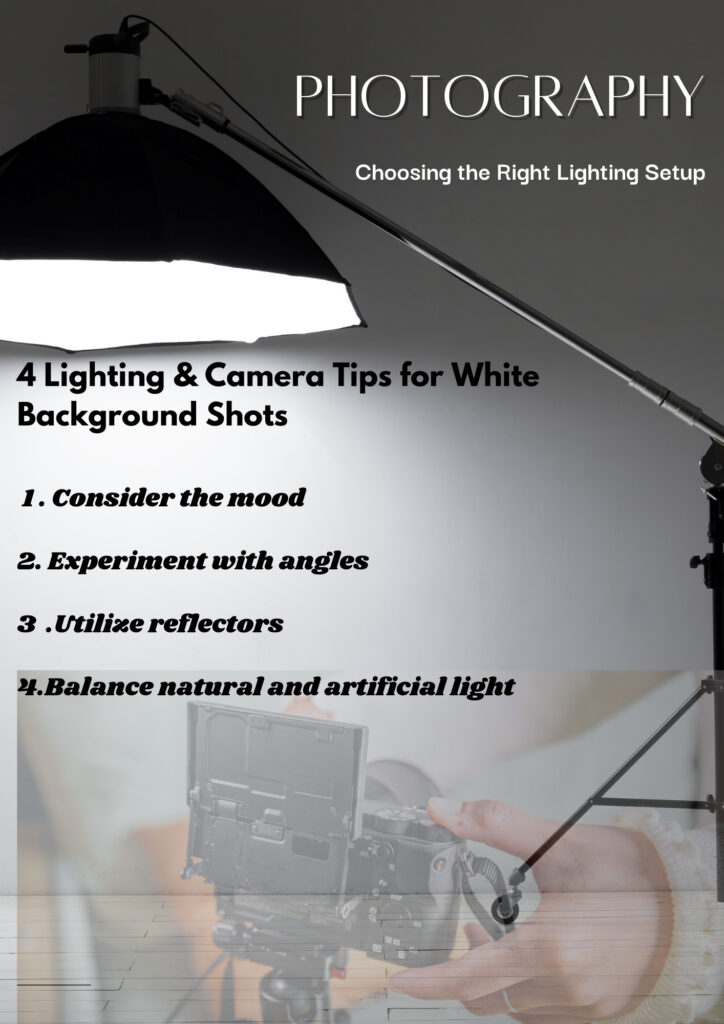Are you struggling to make your product photos pop against a white background? You’re not alone many photographers face this challenge when trying to achieve a polished and professional look. In this article, we will explore five crucial lighting and camera tips specifically designed for white background photography. By following these guidelines, you’ll learn how to create striking images that capture attention and convey professionalism, ultimately helping you to better showcase your products.
Choosing the Right Lighting Setup

- Consider the mood: The right lighting can dramatically alter the mood of your white background photography. Soft, diffused lighting creates a gentle, airy feel, while harsh lighting can produce striking contrasts that demand attention.
- Experiment with angles: The positioning of your light sources is crucial. Side lighting can add depth and texture to your subjects, while overhead lighting can flatten the appearance, making it less dynamic.
- Utilize reflectors: Incorporating reflectors into your setup can enhance your white background photography by bouncing light back onto your subject. This technique helps fill in shadows and adds an element of professionalism to your shots.
- Balance natural and artificial light: Blending natural light with artificial sources can yield captivating results. For instance, shooting near a window during golden hour can infuse warmth, while artificial lights ensure consistency throughout your shoot.
By thoughtfully selecting your lighting setup, you not only highlight the nuances of your subject but also elevate the overall aesthetic of your white background photography. Each light source plays a vital role in crafting the desired atmosphere, so don’t hesitate to experiment until you find the perfect combination. Embrace innovation and let your creativity guide you, turning simple setups into stunning visual narratives.
Using Natural Light Effectively
Harnessing natural light can transform your white background photography, elevating your images from ordinary to extraordinary. The key lies in understanding the quality and direction of light throughout the day. Early morning and late afternoon offer a soft, diffused glow that minimizes harsh shadows, making them ideal for capturing subjects against a white backdrop. Position your subject near a window or outdoors during these golden hours to achieve that ethereal quality, allowing the light to wrap around your subject gracefully.
Additionally, consider the use of reflectors to manipulate natural light further. A simple white reflector can bounce light back onto your subject, enhancing highlights and creating dimension without overwhelming brightness. For outdoor shoots, scouting locations with shaded areas can prevent direct sunlight from washing out details, ensuring your subject stands out crisply against a pristine white background. By experimenting with these techniques, you not only maximize the potential of natural light but also cultivate a signature style that resonates with viewers, capturing their attention and imagination.
Best Artificial Lighting Options
When it comes to white background photography, the right artificial lighting can make all the difference in achieving that crisp, professional look. LED lights are a popular choice due to their energy efficiency and longevity. They emit a consistent color temperature, reducing the risk of unwanted color casts that can disrupt the purity of your white backdrop. Additionally, many LED options come with adjustable brightness settings, allowing photographers to fine-tune their lighting setup according to the subject and environment.
Softbox lights are another excellent artificial lighting option for white background photography. These modifiers diffuse light, creating a soft, even illumination that minimizes harsh shadows and highlights. This is particularly beneficial when photographing products or subjects that require a clean, polished appearance. By positioning softboxes strategically around your setup, you can achieve a professional quality that elevates your work, making it stand out in an increasingly competitive market. Experimenting with different angles and distances can further enhance the depth and texture of your images, ultimately leading to stunning results that captivate your audience.
Positioning Your Subject Correctly
Positioning your subject correctly in white background photography is crucial for achieving a clean and impactful composition. One effective technique is to utilize the rule of thirds, where you divide your frame into a 3×3 grid and place your subject along these lines or at their intersections. This not only creates a sense of balance but also draws the viewer’s eye naturally to the focal point. Additionally, consider the distance between your subject and the background; an optimal gap can help eliminate shadows, ensuring a crisp separation that enhances the minimalist aesthetic characteristic of white background photography.
Lighting plays a pivotal role in positioning as well. Using soft, diffused light can add depth and dimension to your subject, making it pop against the stark backdrop. Experimenting with angles can yield surprising results; for instance, shooting from slightly above or below can create unique perspectives that captivate the viewer. Furthermore, incorporating props or varying textures around your subject can enrich the overall visual narrative without detracting from the simplicity that a white background provides. By thoughtfully considering both position and lighting, you can transform ordinary shots into striking images that convey professionalism and creativity.
Camera Settings for Optimal Shots
When it comes to white background photography, achieving the perfect shot hinges on mastering your camera settings. Start with a low ISO setting, typically around 100 or 200, to minimize noise and enhance image clarity. This is particularly crucial when shooting on a white backdrop, where any grain can detract from the clean, crisp aesthetic you aim for. Coupled with this, an aperture of f/8 to f/11 allows for a greater depth of field, ensuring that your subject remains in sharp focus while the background stays uniformly bright and seamless.
Shutter speed also plays a pivotal role in capturing optimal images. A faster shutter speed will freeze motion, which is essential if you’re photographing dynamic subjects against a white background. However, don’t overlook the importance of lighting; using continuous lights or softboxes can help illuminate your subject evenly and create a beautiful contrast against the backdrop. Experimenting with metering modes can also enhance your results—try spot metering to ensure your subject is correctly exposed without inadvertently blowing out the white background. By carefully adjusting these settings, you can elevate your white background photography to new heights, ensuring each shot reflects professionalism and artistic intent.
Post-Processing Techniques for Enhancement
Post-processing techniques play a crucial role in enhancing white background photography, transforming simple images into striking visual narratives. One of the most effective methods involves utilizing selective color adjustments to make the subject pop against the stark backdrop. By subtly shifting hues and saturation levels, photographers can draw the viewer’s eye directly to the focal point, creating a more dynamic and engaging composition. Additionally, employing tools like the adjustment brush or gradient filters can refine the lighting and contrast, ensuring that every detail stands out without overwhelming the viewer.
Another powerful technique is the use of sharpening and noise reduction, which can significantly elevate the clarity of your subject. In white background photography, where every detail is accentuated, ensuring that your images are crisp yet smooth is essential. Utilizing advanced software features such as frequency separation allows for meticulous control over texture and detail, enabling photographers to enhance intricate elements while maintaining a polished look. Ultimately, thoughtful post-processing not only enhances the aesthetic appeal but also reinforces the storytelling aspect of each image, leaving a lasting impression on the audience.
Common Mistakes to Avoid
One of the most prevalent mistakes in white background photography is neglecting the importance of lighting. Poor lighting can lead to unflattering shadows or highlights that detract from the subject. Utilizing soft, diffused light sources can create an even illumination that enhances the subject’s details while maintaining the starkness of the white background. Investing in quality light diffusers or reflectors can significantly elevate your images, ensuring that the focus remains on the product rather than any distracting elements.
Another common pitfall is overlooking the post-processing stage. Many photographers assume that what they capture on camera is final, but this is where the magic truly happens. Failing to adjust exposure, contrast, and color balance can result in a washed-out appearance that dilutes the effectiveness of white background photography. Moreover, utilizing software to clean up any imperfections or enhance sharpness can make a significant difference in professionalism and visual appeal. Embracing post-processing not only refines the final image but also allows for creative experimentation that can set your work apart in a saturated market.
Mastering White Background Photography
Mastering white background photography requires a keen understanding of light and shadow dynamics. The interplay between these elements can transform a simple subject into a captivating focal point. Utilizing soft, diffused lighting can minimize harsh shadows and create a seamless look that enhances the subject’s features. Experimenting with different light sources such as natural light from a window or artificial softboxes can yield varied results that may surprise even seasoned photographers.
Another essential technique is the careful selection of the white backdrop. A smooth, non-reflective surface can significantly reduce unwanted glare and enhance the clarity of your images. Additionally, consider the distance between the subject and the background; this separation allows for better depth perception and prevents unwanted shadows from casting onto the backdrop. By honing in on these nuances, photographers can elevate their white background photography, producing images that are not only professional but also visually striking.


